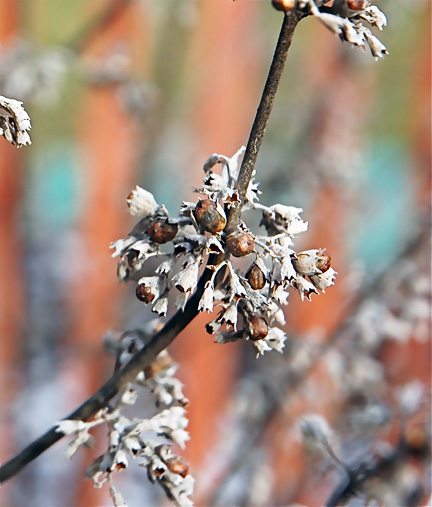| General Description | The Chaste Tree is a deciduous or evergreen tree or shrub (depending on growing location and severity of seasons), with gorgeous bright blue fragrant flowers that bloom late summer to mid-autumn. It is generally a pest and disease tolerant plant that has been used as medicine. It takes about 10 - 20 years to reach maturity. |
| ID Characteristic | The Chaste Tree has an aromatic bright blue flower panicle, which relates to its other common name, the Sage Tree. Its palmately compound dark green leaves have 5 - 7 fingerlike leaflets which resemble Cannabis sativa, which relates to another common name, Hemp Tree. Its seeds originating from fleshy fruit are similar to black pepper. It is stable in form and colour and resistant to pests and diseases. |
| Shape | Vertical, low growing, somewhat rounded shrub. |
| Landscape | The Chaste tree can be used as a multi-season specimen or summer flowering plant because of its bright blue flowers through late summer to mid-autumn. In autumn dark green foliage changes to bright yellow, therefore it can be used as seasonal or autumn interest plant. |
| Propagation | Sow seed in spring or autumn. Semi-ripe cuttings in summer. |
| Cultivation | The Chaste tree can be grown in full sun to partial shade, but prefers full sun for best results. It tolerates wet soil conditions but it has to be well-drained. Plants should be planted in the spring or autumn. If pruning is required, wait until spring growth flushes as the plant is a half-hardy. |
| Pests | It has few pest and disease problems. However it is susceptible to mushroom root rot and nematodes. |
| Notable Specimens | The Chaste tree can be found in old gardens in Southern Mediterranean region. |
| Habitat | The Chaste Tree grows the best in moist, but well-drained sandy, chalky or loamy soil in full sun. The pH level of soil can be either acidic, alkaline or neutral between from 5.6 to 7.5. It needs to be planted in sheltered areas to avoid cold and drying winds. The distance between plants has to be over 100 cm. |
| Bark/Stem Description | It has a smooth grey brown barks and it becomes blocky as it matures. |
| Leaf Description | This plant have a broad leaves with entire edges, they are glossy, with 5–7 fingerlike leaflets that often resemble Cannabis sativa. Leaves are about 7.6–10 cm in diameter and are palmately compound. It smells aromatic when crushed and changes colour from dark green to yellow during autumn |
| Flower Description | Panicles of small flowers grow up to 18 cm on the end of the branch tips, blooms bright blue in late summer to mid-autumn. Its scented showy flowers attract hummingbirds, bees and butterflies. When it is full bloom it is reminiscent of the butterfly bush for which it is often mistaken. |
| Fruit Description | The Chaste tree produces reddish fruit that matures to black as it ripens. It smells and tastes like black pepper for which the seeds are sometimes used. Fruit powder or dry extracts are often used as traditional herbal medicines for the relief of menstruation and cyclic breast pain. |
| Colour Description | It has a dark green foliage that changes to yellow during autumn. It has beautiful blue and purple panicles in late summer to mid-autumn. |
| Texture Description | Medium fine texture. |
.jpg)
.jpg)
.jpg)
